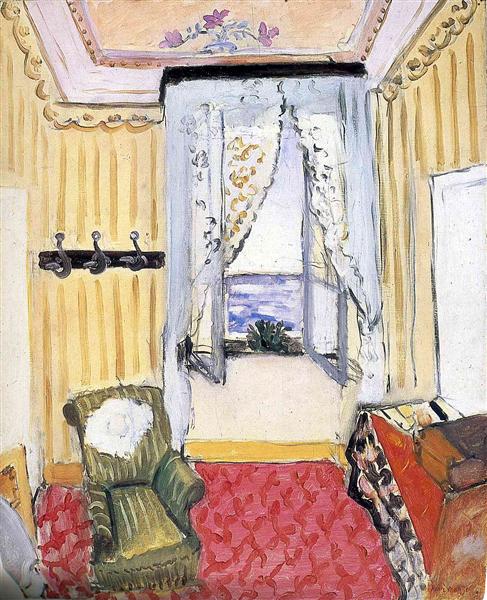Description
The canvas "My Room at the Beau-Rivage" by Henri Matisse, painted in 1918, is a work that masterfully synthesizes the artist's aesthetics and sensitivity during his mature period. With dimensions of 49x60 cm, this painting is an intimate and personal representation of his room at the Beau-Rivage hotel in Nice, a city that deeply influenced his later work.
Henri Matisse, known for his bold use of color and his ability to simplify forms without losing their essence, manages to create a vibrant and cozy atmosphere in this painting. The room is presented with a rich chromatic palette, where warm and earthy tones predominate, combined with softer and fresher shades. Matisse's goal is not simply to portray a physical space but to transform his everyday surroundings into a visual experience that communicates emotions and sensations.
A detailed inspection of the work reveals a space flooded by soft natural light, discreetly entering through the open window in the background. This diffuse light enhances the tranquility of the place and underscores the importance of the private environment for the artist. The composition is populated with a series of domestic elements that intertwine without apparent hierarchy: a vase with flowers, a desk, a chair, and on the table, scattered papers and books. Each object is treated with equal attention and consideration, reflecting an almost mundane everyday moment, but elevated by the artist's eye to a level of poetic contemplation.
There are no visible human figures in the scene, but Matisse's presence is felt in every brushstroke. The arrangement of the elements does not follow a classical perspective but adopts a freer and more personal planning, characteristic of his style. This creates a pictorial space where objects seem to coexist in harmonious balance, guided more by emotions than by geometric rules.
The use of color is decisive in this piece. Matisse applies color in a flat and direct manner, without large shadows or gradations, which gives the painting a clarity and apparent simplicity that adds to its appeal. The combination of ochres, muted reds, greens, and soft blues creates a pleasant and cozy, almost tactile atmosphere. This economy in the use of color and line is a distinctive feature of the artist, who sought to express the maximum with the minimum of resources.
The historical context of 1918, at the end of World War I, adds an additional layer of interpretation to the work. In times of uncertainty and change, Matisse seems to be sheltered in the calm and security of his personal environment. The detailed representation of his room could be interpreted as a search for stability and beauty amid external chaos, turning his intimate space into a sanctuary.
To better understand "My Room at the Beau-Rivage," it is useful to consider other works by Matisse from the same period, such as "Interior with a Violin Case" (1918) or "The Piano Lesson" (1916), where his interest in capturing interior life and domestic atmosphere through a visual language that prioritizes emotion over mimesis is also evident.
In summary, "My Room at the Beau-Rivage" is an exemplary showcase of Henri Matisse's talent for transforming the everyday into sublime art. Through a careful composition, a masterful use of color, and a personal interpretation of space, Matisse invites us to share an intimate and serene moment of his life, offering us a window into his personal and artistic universe.

